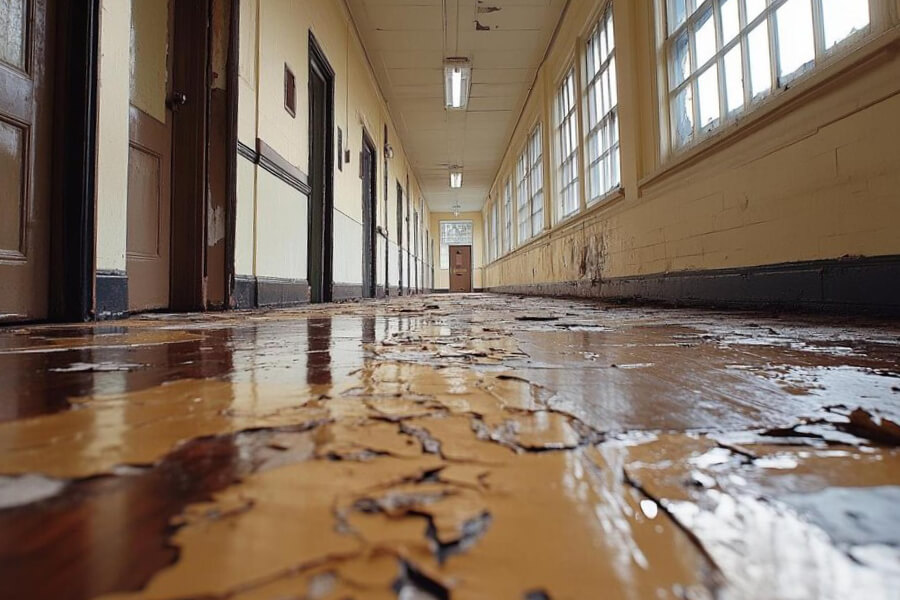San Antonio, home to several prestigious universities, faces unique challenges when it comes to water emergencies. From flash floods to burst pipes, these institutions must be prepared to handle a variety of water-related incidents. This article explores how San Antonio universities are tackling water emergencies, ensuring the safety of students and staff while protecting valuable resources and infrastructure.
Common Water Emergencies in San Antonio Universities
- Flash Flooding: San Antonio’s prone to sudden, heavy rainfall.
- Pipe Bursts: Aging infrastructure can lead to unexpected water leaks.
- HVAC System Leaks: Condensation issues in large campus buildings.
- Laboratory Incidents: Water-based experiments gone awry.
- Sprinkler System Malfunctions: Can cause significant water damage.
Key Universities and Their Approaches
University of Texas at San Antonio (UTSA)
UTSA has implemented a comprehensive water emergency response plan:
- 24/7 emergency response team
- Regular drills and training for staff and students
- Advanced water detection systems in key buildings
- Partnerships with local water damage restoration company near me
Trinity University
Trinity focuses on prevention and rapid response:
- State-of-the-art weather monitoring system
- Upgraded drainage systems across campus
- Emergency notification system for students and staff
- Contracts with water mitigation services near me for quick action
St. Mary’s University
St. Mary’s emphasizes education and preparedness:
- Mandatory water safety training for all new students
- Regular maintenance checks on plumbing and HVAC systems
- Designated safe zones in case of severe flooding
- Collaboration with local experts for water removal near me
Innovative Technologies in Use
San Antonio universities are leveraging cutting-edge technologies:
- Smart Water Sensors: Detect leaks and unusual water flow patterns.
- AI-Powered Predictive Maintenance: Identifies potential issues before they become emergencies.
- Drone Surveillance: For quick assessment of flood-prone areas during heavy rains.
- Mobile Apps: Allow students and staff to report water issues instantly.
Emergency Response Protocols
When water emergencies occur, universities follow these steps:
- Immediate Alert: Notify students, staff, and emergency services.
- Safety First: Evacuate affected areas if necessary.
- Source Control: Shut off water sources if possible.
- Damage Assessment: Quickly evaluate the extent of water damage.
- Professional Intervention: Contact water extraction company near me for rapid response.
Collaboration with Local Authorities
San Antonio universities work closely with:
- San Antonio Water System (SAWS)
- Local Fire Department
- City Emergency Management Office
- Professional water remediation company near me
This collaboration ensures a coordinated response to large-scale water emergencies.
Student Involvement and Education
Universities are actively involving students in water emergency preparedness:
- Student-led emergency response teams
- Water conservation clubs promoting awareness
- Integration of water management courses in relevant curricula
- Volunteer opportunities with local flood control projects
Challenges and Solutions
Challenge 1: Aging Infrastructure
- Solution: Phased replacement of old pipes and systems
- Regular inspections and preventive maintenance
Challenge 2: Large Campus Areas
- Solution: Zoned emergency response plans
- Strategically placed emergency equipment across campuses
Challenge 3: High Student Turnover
- Solution: Annual emergency preparedness training
- Easy-to-access online resources for water emergency protocols
Funding and Resource Allocation
Universities are prioritizing water emergency preparedness through:
- Dedicated budget for water management infrastructure
- Grants for innovative water-saving and emergency response technologies
- Partnerships with private sector for cost-effective solutions
Best Practices for Students and Staff
- Stay Informed: Know your campus emergency procedures.
- Report Issues: Immediately report any signs of water damage or leaks.
- Be Prepared: Keep important documents and valuables in waterproof containers.
- Follow Instructions: Adhere to university guidelines during water emergencies.
- Stay Updated: Keep emergency contact numbers handy, including for water damage restoration company near me.
Long-Term Strategies
San Antonio universities are looking ahead with:
- Climate Resilience Plans: Adapting campuses to changing weather patterns.
- Water Recycling Systems: Reducing dependence on city water supply.
- Green Infrastructure: Implementing permeable pavements and rain gardens.
- Research Initiatives: Leading studies on urban water management.
Conclusion: Leading by Example
San Antonio’s universities are not just tackling water emergencies; they’re setting standards for urban water management. Through a combination of advanced technology, comprehensive planning, and community engagement, these institutions are creating resilient campuses capable of withstanding and quickly recovering from water-related incidents.
As climate change brings more unpredictable weather patterns, the proactive approach of San Antonio’s universities serves as a model for other institutions and communities. By prioritizing preparation, leveraging technology, and fostering a culture of awareness, these universities are ensuring that they can continue their mission of education and research, come rain or shine.
Remember, in the face of water emergencies, knowledge, preparation, and quick action are key. San Antonio’s universities are leading the way in all three aspects, creating safer, more resilient campuses for generations of students to come.









